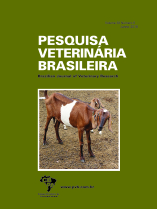 |
|
|
|
Year 2018 - Volume 38, Number 6
|

|
Bacterial resistance in bats from the Phyllostomidae family and its relationship with unique health, 38(6):1207-1216
|
ABSTRACT.- Sens-Junior H., Trindade W.A., Oliveira A.F., Zaniolo M.M., Serenini G.F., Araujo-Ceranto J.B., Gonçalves D.D. & Germano R.M. 2018. Bacterial resistance in bats from the Phyllostomidae family and its relationship with unique health. [Resistência bacteriana em morcegos da família Phyllostomidae e sua relação com a saúde única.] Pesquisa Veterinária Brasileira 38(6)1207-1216. Programa de Pós-Graduação em Ciência Animal com Ênfase em Produtos Bioativos, Universidade Paranaense, Praça Mascarenhas de Moraes 4282, Zona III, Umuarama, PR 87502-210, Brazil. E-mail: prof.ricardogermano@gmail.com
The Phyllostomidae family is important among the bats found in Brazil, with several species and diverse eating habits, and is the only one to have frugivorous representatives. These bats can be found in urban and in wild life environments in search for the best reproductive and feeding conditions. The versatility of environments can be associated with the incidence and/or distribution of some diseases through pathogenic agents. The present paper has the purpose to identify the oral and perianal microbiota and to detect the bacterial resistance of frugivorous bats captured near communities inhabited by humans in the northwestern region of the state of Paraná. A total of 68 bats were captured, belonging to four species of the Phyllostomidae family, namely Artibeus lituratus, Artibeus planirostris, Carollia perspicillata and Sturnira lillium, originated from forest fragments in the micro region of Umuarama, state of Paraná. A total of 64 isolates from oral bacteria and 39 from perianal region were submitted to identification. They were later submitted to a susceptibility test to 22 human and veterinary antimicrobials. The most prevalent bacteria were Escherichia coli 33.3% in the oral region, and 35.90% in the perianal region, Enterobacter aerogenes 12.7% and 5.13%, Enterobacter agglomerans 7.9% and 10.25%, and Serratia liquefaciens 9.5% and 5.13% in the oral and perianal region respectively. All bat species studied had resistant strains, with a few of them presenting multi-resistance to antimicrobials. The species with the highest multi-resistance index to antimicrobials was Carollia perspicillata, with three strains of the oral region resistant to 15 antimicrobials; it also presented two strains in the perianal region, which were resistant to 13 and 10 antimicrobials respectively. Based on the results found, it is possible to conclude that the oral and perianal microbiota of bats is composed of several enterobacterial species resistant to one or several antimicrobials used in human and veterinarian medicine. This is an issue and a future warning for unique health, since high percentages of resistance were found against antimicrobials broadly used, such as ampicillin, amoxicillin and amoxicillin+clavulonate. |
| |
|
|
| |
|
 |